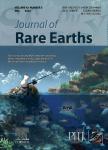Synthesis of Spherical (Y,Gd)BO_3:Eu^(3+)Phosphor Using W/O Emulsion System
Synthesis of Spherical (Y,Gd)BO_3:Eu^(3+)Phosphor Using W/O Emulsion System作者机构:National Engineering Research Center for Rare Earth Materials General Research Institute for Nonferrous Metals Grirem Advanced Materials Co. Ltd. Beijing 100088 China
出 版 物:《Journal of Rare Earths》 (稀土学报(英文版))
年 卷 期:2006年第24卷第6期
页 面:719-723页
核心收录:
学科分类:0709[理学-地质学] 0819[工学-矿业工程] 07[理学] 0708[理学-地球物理学] 0703[理学-化学] 070301[理学-无机化学]
基 金:Project supported by National Hi-Tech . R&D Program of China (863 Program 2002AA302604) MOST of China(2006CB601104) and Synchrotron Radiation fund of Innovation Project of Ministry of Education (20041213S)
主 题:emulsion W/O PDP phosphor photoluminescence (PL) property VUV rare earths
摘 要:Spherical (Y, Gd)BO3:Eu^3+ phosphor particles with a narrow size distribution(2 -4 μm) was obtained by firing the Y-Gd-Eu-BO3 precursor prepared in a W/O style emulsion system. In the W/O emulsion system, kerosene, used as oil phase, was mixed with Span 80 and Tween 80 compounds which were employed as the emulsifier with an HLB (hydrophile-lipophile balance) value of 5.2- 5.3. Both rare earths (Y, Gd and Eu) nitrate and boric acid solution or ammonia solution were used as aqueous phase. The synthesis conditions, such as emulsion composition, emulsifying style, precipitation reaction process, reaction temperature, morphology control, and so on, were investigated, and the optimum synthesis conditions for preparing spherical (Y, Gd)BO3:Eu^3+ phosphor was obtained. The phosphor was characterized by XRD, SEM, laser particle size analysis, emission and excitation spectrum under vacuum ultraviolet (VUV), and so on. The phosphor synthesized using the water-in-oil emulsion method with median diameter (D50) of 2 - 4 μm shows agreeable photoluminescence (PL) property and sphericity. The main emission peak appears at about 593 nm, which corresponds to ^5D0→^7F1 transition (magnetic-dipole transition) of the Eu^3+ ion. The cell parameters and powder diffraction data were indexed. The structure of the phosphor belongs to the hexagonal system with space group P63/m.



